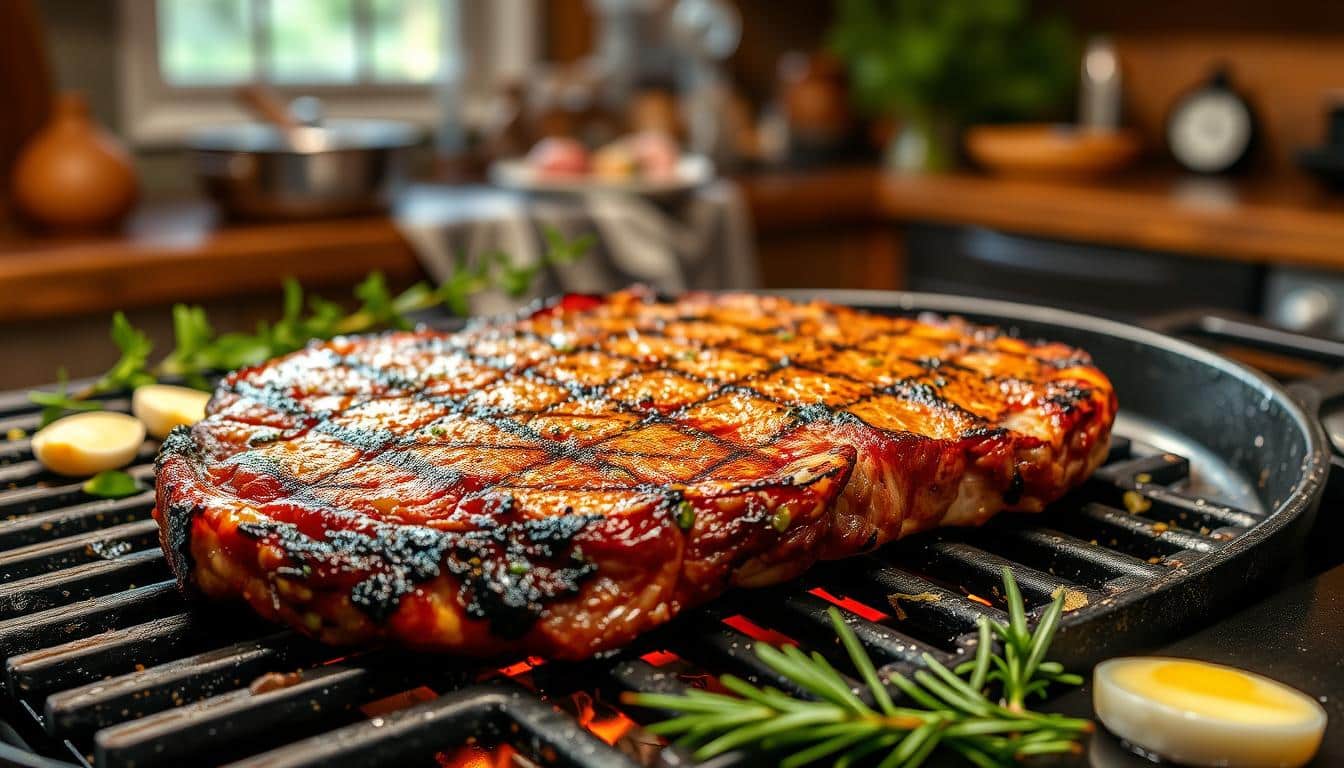Want a juicy, flavorful steak but don’t know how to make it at home? We’ve got you covered. This guide will show you the best ways to cook steak at home. You’ll learn how to pick the right cuts and master different cooking techniques.
Whether you’re new to cooking or want to get better, our tips will help. We’ll cover everything from the right tools to getting the steak just right. By the end, you’ll be able to make a steak that’s as good as your favorite restaurant’s.
Ready to learn how to make the perfect steak at home? Let’s explore the world of steak cooking together. Get ready to make your dining experience better and become the steak master you’ve always wanted to be.
Understanding Different Cuts of Steak
Choosing the right steak can really make your meal special. We’ll look at different cuts, from the best to the more affordable ones. We’ll also talk about how marbling affects taste.
Premium Cuts
Ribeye, filet mignon, and strip steak are favorites among steak fans. Ribeye is known for its rich taste and softness, thanks to its fat content. Filet mignon is famous for being very tender. Strip steak offers a great mix of taste and texture.
Budget-Friendly Options
Flank, skirt, and flat iron steaks are good for those watching their budget. They might need special cooking but can taste amazing if done right.
Marbling and Its Impact on Flavor
Marbling is the fat inside the meat. It’s key to a steak’s taste, juiciness, and softness. More marbling means a tastier and softer steak.
| Steak Cut | Marbling Level | Flavor Profile | Best Cooking Method |
|---|---|---|---|
| Ribeye | High | Rich, beefy | Grilling, pan-searing |
| Filet Mignon | Low | Mild, tender | Pan-searing, broiling |
| Strip Steak | Medium | Balanced | Grilling, pan-searing |
| Flank Steak | Low | Intense beef flavor | Grilling, broiling |
| Skirt Steak | Medium | Strong, beefy | High-heat grilling |
Essential Tools and Equipment for Steak Cooking
Cooking the perfect steak starts with the right tools. We’ll look at the essential equipment for better steak cooking at home.
Cast Iron Skillet vs. Grill Pan
A cast iron skillet is great for steak. It keeps heat well, making a nice crust. It cooks steak evenly and brings out great flavors.
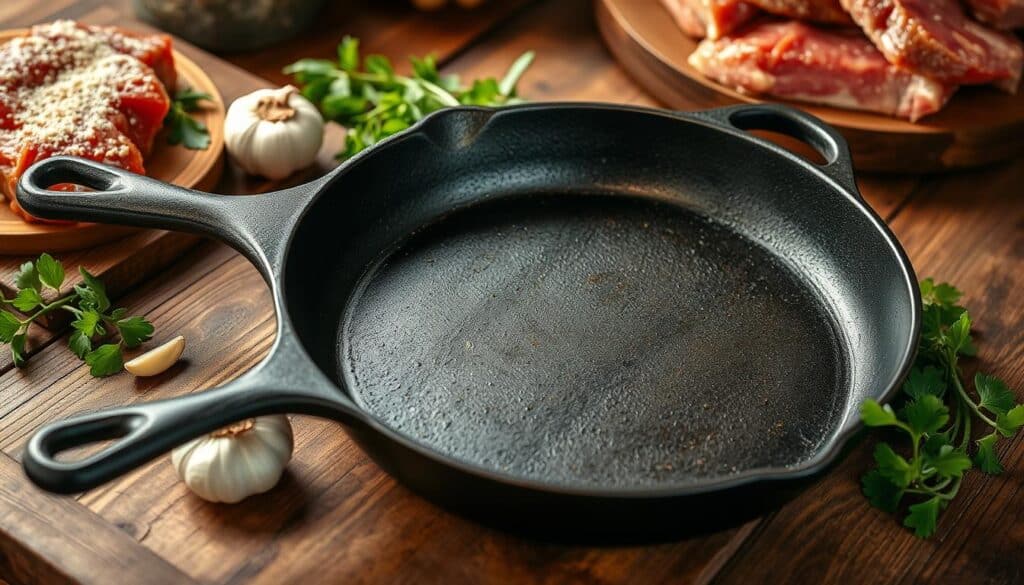
Temperature Probes and Thermometers
It’s key to check steak temperature for the right doneness. Instant-read thermometers give quick, accurate readings. For more precision, use a leave-in probe thermometer.
| Doneness | Steak Temperature |
|---|---|
| Rare | 125°F (52°C) |
| Medium Rare | 135°F (57°C) |
| Medium | 145°F (63°C) |
Tongs and Other Handling Tools
Long-handled tongs are key for safely flipping steak. Don’t use forks, as they can pierce the meat and lose juices. A strong spatula helps press down on the steak for a better crust.
With these tools, you’ll cook steaks like a pro. The right gear and technique are essential for a perfect, juicy steak every time.
How to Cook Steak: Basic Techniques
Learning to cook steak is key for any home chef. We’ll cover the basic methods to make a tasty meal. Mastering these techniques will help you try more advanced cooking.
Getting a great steak starts with controlling heat and timing. Use high heat first for a nice sear. Then, lower the heat to cook the inside right.
Handling your steak right is also important. Use tongs to flip it, not forks. This keeps juices inside. Let the steak rest after cooking to spread the juices evenly.
“The secret to a perfect steak is patience and practice. Don’t be afraid to experiment with different techniques to find what works best for you.”
Here’s a quick guide to basic steak cooking times based on thickness:
| Thickness | Rare | Medium | Well Done |
|---|---|---|---|
| 1 inch | 3-4 minutes per side | 5-6 minutes per side | 8-10 minutes per side |
| 1.5 inches | 4-5 minutes per side | 6-7 minutes per side | 10-12 minutes per side |
| 2 inches | 5-6 minutes per side | 7-8 minutes per side | 12-14 minutes per side |
By learning these basics, you’re ready to try different steak cooking methods. We’ll share more tips and techniques to improve your steak cooking in the next sections.
Preparing Your Steak Before Cooking
Great steak preparation starts long before the meat hits the pan. We’ve got the inside scoop on getting your steak ready for its starring role. From temperature tips to seasoning secrets, these steps will elevate your steak game.
Room Temperature Guidelines
Take your steak out of the fridge about 30 minutes before cooking. This lets it warm up, ensuring even cooking. Cold steaks can lead to a tough exterior and undercooked center – not what we’re aiming for!
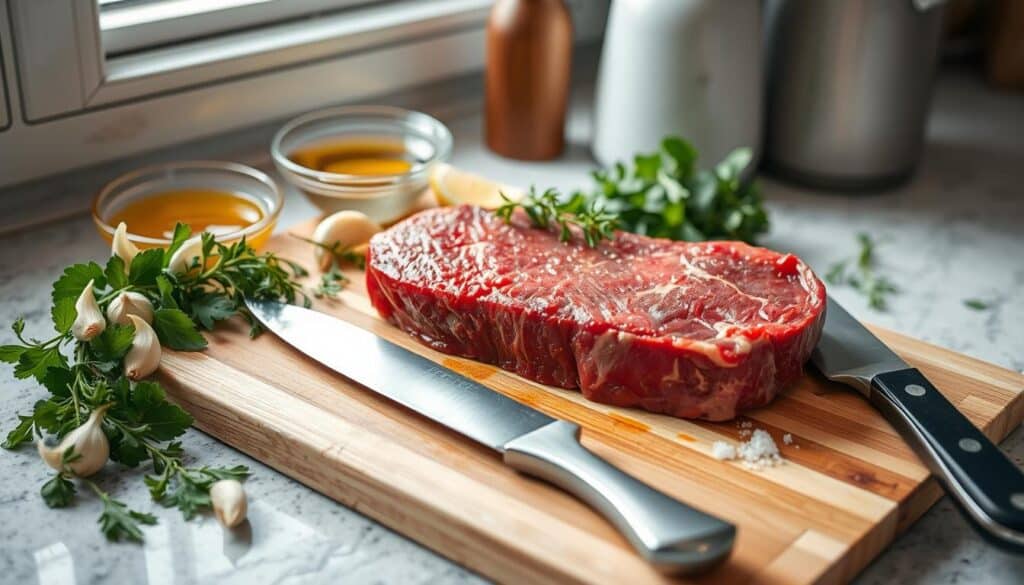
Seasoning Methods and Timing
Steak seasoning is an art form. Start with a generous sprinkle of kosher salt and freshly ground black pepper. Pat it into the meat, covering all sides. For bolder flavors, try a rub with garlic powder, paprika, or dried herbs. Season your steak right before cooking for the best results.
Dry Brining Benefits
Want to take your steak to the next level? Try dry brining. Salt your steak and let it sit uncovered in the fridge for 1-2 hours or overnight. This process draws out moisture, which then gets reabsorbed, seasoning the meat deeply and improving its texture.
“A well-prepared steak is halfway to perfection before it even touches the heat.”
Remember, great steak preparation is the foundation of a mouthwatering meal. These simple steps will help you achieve steakhouse-quality results right in your own kitchen.
Popular Cooking Methods Explained
Learning different steak cooking techniques can make you a better cook. We’ll look at three popular ways to make your beef taste amazing.
Pan-Searing Technique
Pan-searing steak is quick and tasty, great for beginners. Start with a hot cast-iron skillet. Dry your steak and season it well. Put it in the hot pan for 3-5 minutes on each side.
This makes a tasty crust and keeps the inside juicy. For thicker steaks, finish cooking in a preheated oven.
Grilling Fundamentals
Grilling steak adds a smoky flavor that’s unbeatable. Heat your grill to high. Clean and oil the grates to avoid sticking.
Put your seasoned steak on the hottest part of the grill. Cook for 4-5 minutes per side for medium-rare. Adjust cooking time for your liking. Let it rest before slicing.
Reverse Searing Method
Reverse-searing steak uses low heat first, then a high-heat sear. Start by slow-roasting your steak in a 275°F oven. Cook until it’s 10-15°F below your target temperature.
Then, sear it in a very hot pan for a perfect crust. This method ensures even cooking and a juicy inside. It’s perfect for thick cuts like ribeye or hamburger steak.
| Method | Best For | Cooking Time |
|---|---|---|
| Pan-Searing | Thin to medium cuts | 6-10 minutes |
| Grilling | All cuts | 8-12 minutes |
| Reverse Searing | Thick cuts | 45-60 minutes |
Each method has its own benefits. Try them out to find your favorite way to cook the perfect steak!
Temperature Guide for Perfect Doneness
Learning about steak doneness levels is key for a great meal. We’ve made a detailed guide to help you get the perfect steak temperature every time. Knowing these levels means you’ll cook your steak just right.
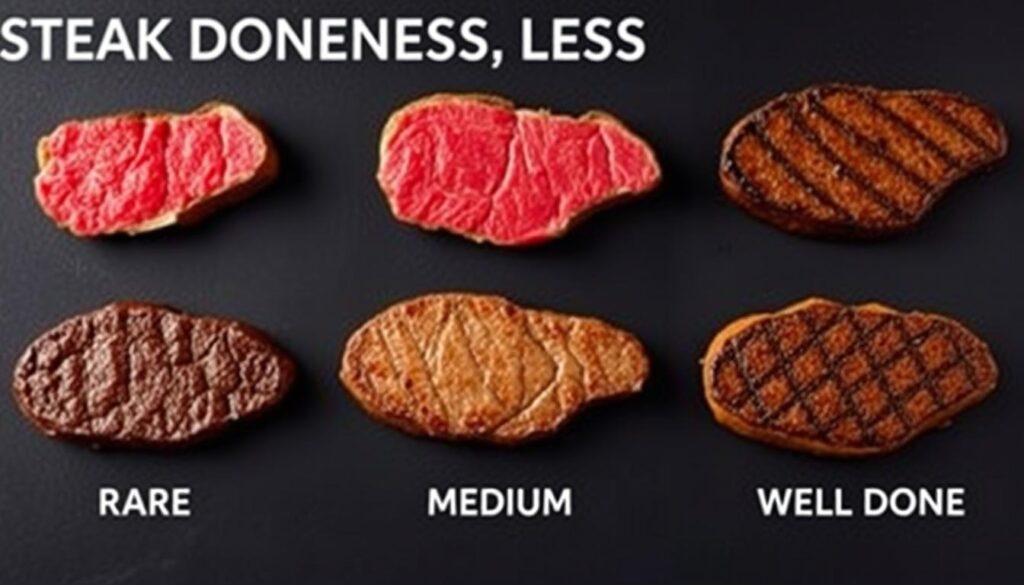
Now, let’s look at the different steak doneness levels and their internal temperatures:
| Doneness Level | Internal Temperature (°F) | Description |
|---|---|---|
| Rare | 125-130°F | Cool red center, very soft |
| Medium Rare | 130-140°F | Warm red center, slightly firm |
| Medium | 140-150°F | Warm pink center, firmer texture |
| Medium Well | 150-160°F | Slightly pink center, mostly firm |
| Well Done | 160°F and above | Little to no pink, very firm |
Take your steak off the heat when it’s about 5°F below your target. It will keep getting hotter as it rests. Always use a meat thermometer for exact results.
Try different doneness levels to find what you like best. Whether you love a juicy rare steak or prefer it well done, knowing these temperatures will make you a better steak cook.
Mastering Steak Seasoning
Improving your steak’s taste starts with seasoning. We’ll look at ways to make your steak better, from simple to complex.
Salt and Pepper Basics
Good steak seasoning begins with salt and pepper. Use coarse sea salt and fresh black pepper. Sprinkle both sides of your steak with it 30 minutes before cooking.
Herb and Spice Combinations
Enhance your steak with herb and spice mixes. Try garlic powder, dried rosemary, and thyme for a classic taste. For a bolder flavor, mix paprika, cumin, and chili powder. Make sure the flavors don’t hide the meat’s natural taste.
Marinade Options
A good steak marinade adds amazing flavor. Mix olive oil, soy sauce, garlic, and lemon juice for a simple marinade. For something more complex, try a red wine marinade with shallots and herbs. Marinate for 2 to 8 hours to keep the meat tender.
- Teriyaki marinade: Soy sauce, mirin, brown sugar, ginger
- Chimichurri marinade: Parsley, cilantro, garlic, red wine vinegar
- Bourbon marinade: Bourbon, brown sugar, Worcestershire sauce
Mastering these seasoning techniques lets you make top-notch steaks at home. Try different mixes to find your favorite flavor.
Common Steak Cooking Mistakes to Avoid
Learning how to cook steak can really improve your cooking skills. But, it’s also key to know and avoid common mistakes. We’ve listed some common errors that can ruin a good steak.
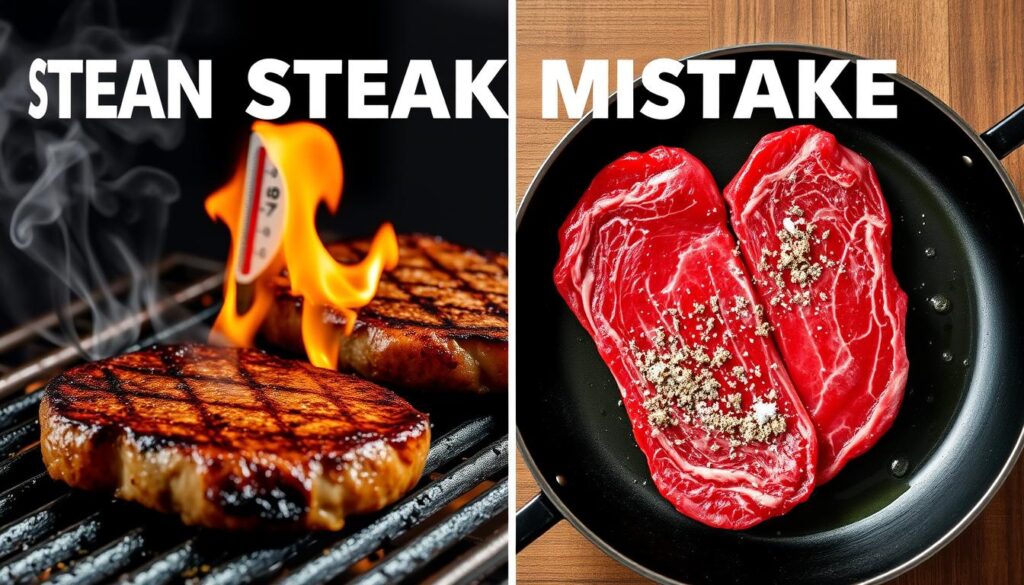
One big mistake is overcooking. Many people cook their steaks too long, making them dry and tough. To fix this, use a meat thermometer. Take the steak off the heat when it’s 5°F below your desired doneness.
Another mistake is not seasoning right. Some people don’t season enough, while others season too much. A good trick is to use about 1 teaspoon of salt for every pound of meat. Make sure to season all sides evenly.
Not letting the steak rest after cooking is a big error. Resting lets the juices spread out, making the steak juicy and tasty. Let your steak rest for about 5 minutes for every inch of thickness.
| Mistake | Consequence | Solution |
|---|---|---|
| Overcooking | Dry, tough meat | Use a meat thermometer |
| Improper seasoning | Bland or overly salty taste | 1 tsp salt per pound of meat |
| Not resting the steak | Loss of juices when cutting | Rest 5 minutes per inch thickness |
By avoiding these common mistakes and following good steak cooking tips, you’ll make great steaks at home. You’ll be cooking like a pro in no time.
Resting and Serving Your Steak
After cooking your steak, it’s time for the resting period. This step helps the juices spread out. It makes your steak tender and full of flavor. Let’s learn how to rest and serve your steak for a great meal.
Proper Resting Times
The resting time depends on the steak’s thickness. A 1-inch thick steak should rest for 5-7 minutes. Thicker steaks might need 10-15 minutes. Cover the steak with foil to keep it warm and moist.
| Steak Thickness | Resting Time |
|---|---|
| 1 inch | 5-7 minutes |
| 1.5 inches | 7-10 minutes |
| 2 inches or more | 10-15 minutes |
Slicing Techniques
Proper slicing is important for serving steak. Always cut against the grain for tenderness. Use a sharp knife and slice at an angle for a nice look. For skirt steak, thin slices are best.
Serving Suggestions
Here are some ways to make your steak serving better:
- Pair with roasted vegetables for a balanced meal
- Serve with creamy mashed potatoes
- Add compound butter for extra flavor
- Garnish with fresh herbs like rosemary or thyme
The resting period is as key as cooking. It makes your steak juicy and tasty. Follow these tips to serve steak like a pro.
Accompanying Sauces and Side Dishes
A perfect steak needs the right sides. Let’s look at classic steak sauces and side dishes. They’ll make your meal feel like it’s from a fancy restaurant.
Classic Steak Sauces
Steak sauces can make your meat taste even better. Here are some favorites:
- Béarnaise: A rich, buttery sauce with tarragon and shallots
- Peppercorn: Creamy and spicy, made with crushed peppercorns
- Chimichurri: A tangy Argentinian sauce with herbs and garlic
- Mushroom: Savory sauce made with sautéed mushrooms and cream
Complementary Side Dishes
Choosing the right sides can make your meal unforgettable. Here are some great options:
| Side Dish | Description |
|---|---|
| Roasted Potatoes | Crispy outside, fluffy inside, seasoned with herbs |
| Grilled Asparagus | Lightly charred, drizzled with olive oil and lemon |
| Creamed Spinach | Rich and velvety, perfect with a juicy steak |
| Sautéed Mushrooms | Earthy flavors that complement the meat beautifully |
The secret to a great steak dinner is balance. Pick sauces and sides that match your steak’s flavors. Don’t let them overpower it. Try different combinations to find your favorite!
Conclusion
We’ve looked into cooking the perfect steak, from picking cuts to serving. Learning to cook steak at home is rewarding. The secret to a great steak is quality cuts, proper prep, and mastering cooking.
Each cooking method, like pan-searing, grilling, or reverse searing, has its own perks. Remember to let your steak rest before slicing. This simple step can greatly improve the taste.
As you keep practicing, you’ll find your own way to cook the perfect steak. Try different seasonings and sides to make your steak dinner just right. Soon, you’ll be making steaks as good as restaurants in your own kitchen.

